 Artificial intelligence is having a profound effect on economies and society. From production, to services, to healthcare, to pharmaceuticals; to education, to research, to data analysis; to software, to search engines; to planning, to communication, to legal services, to social media – to our everyday lives, AI is transforming the way humans interact. And that transformation is likely to accelerate. But what will be the effects on GDP, on consumption, on jobs, on the distribution of income, and human welfare in general? These are profound questions and ones that economists and other social scientists are pondering. Here we look at some of the issues and possible scenarios.
Artificial intelligence is having a profound effect on economies and society. From production, to services, to healthcare, to pharmaceuticals; to education, to research, to data analysis; to software, to search engines; to planning, to communication, to legal services, to social media – to our everyday lives, AI is transforming the way humans interact. And that transformation is likely to accelerate. But what will be the effects on GDP, on consumption, on jobs, on the distribution of income, and human welfare in general? These are profound questions and ones that economists and other social scientists are pondering. Here we look at some of the issues and possible scenarios.
According to the Merrill/Bank of America article linked below, when asked about the potential for AI, ChatGPT replied:
AI holds immense potential to drive innovation, improve decision-making processes and tackle complex problems across various fields, positively impacting society.
But the magnitude and distribution of the effects on society and economic activity are hard to predict. Perhaps the easiest is the effect on GDP. AI can analyse and interpret data to meet economic goals. It can do this much more extensively and much quicker than using pre-AI software. This will enable higher productivity across a range of manufacturing and service industries. According to the Merrill/Bank of America article, ‘global revenue associated with AI software, hardware, service and sales will likely grow at 19% per year’. With productivity languishing in many countries as they struggle to recover from the pandemic, high inflation and high debt, this massive boost to productivity will be welcome.
But whilst AI may lead to productivity growth, its magnitude is very hard to predict. Both the ‘low-productivity future’ and the ‘high-productivity future’ described in the IMF article linked below are plausible. Productivity growth from AI may be confined to a few sectors, with many workers displaced into jobs where they are less productive. Or, the growth in productivity may affect many sectors, with ‘AI applied to a substantial share of the tasks done by most workers’.
Growing inequality?
 Even if AI does massively boost the growth in world GDP, the distribution is likely to be highly uneven, both between countries and within countries. This could widen the gap between rich and poor and create a range of social tensions.
Even if AI does massively boost the growth in world GDP, the distribution is likely to be highly uneven, both between countries and within countries. This could widen the gap between rich and poor and create a range of social tensions.
In terms of countries, the main beneficiaries will be developed countries in North America, Europe and Asia and rapidly developing countries, largely in Asia, such as China and India. Poorer developing countries’ access to the fruits of AI will be more limited and they could lose competitive advantage in a number of labour-intensive industries.
Then there is growing inequality between the companies controlling AI systems and other economic actors. Just as companies such as Microsoft, Apple, Google and Meta grew rich as computing, the Internet and social media grew and developed, so these and other companies at the forefront of AI development and supply will grow rich, along with their senior executives. The question then is how much will other companies and individuals benefit. Partly, it will depend on how much production can be adapted and developed in light of the possibilities that AI presents. Partly, it will depend on competition within the AI software market. There is, and will continue to be, a rush to develop and patent software so as to deliver and maintain monopoly profits. It is likely that only a few companies will emerge dominant – a natural oligopoly.
Then there is the likely growth of inequality between individuals. The reason is that AI will have different effects in different parts of the labour market.
The labour market
 In some industries, AI will enhance labour productivity. It will be a tool that will be used by workers to improve the service they offer or the items they produce. In other cases, it will replace labour. It will not simply be a tool used by labour, but will do the job itself. Workers will be displaced and structural unemployment is likely to rise. The quicker the displacement process, the more will such unemployment rise. People may be forced to take more menial jobs in the service sector. This, in turn, will drive down the wages in such jobs and employers may find it more convenient to use gig workers than employ workers on full- or part-time contracts with holidays and other rights and benefits.
In some industries, AI will enhance labour productivity. It will be a tool that will be used by workers to improve the service they offer or the items they produce. In other cases, it will replace labour. It will not simply be a tool used by labour, but will do the job itself. Workers will be displaced and structural unemployment is likely to rise. The quicker the displacement process, the more will such unemployment rise. People may be forced to take more menial jobs in the service sector. This, in turn, will drive down the wages in such jobs and employers may find it more convenient to use gig workers than employ workers on full- or part-time contracts with holidays and other rights and benefits.
But the development of AI may also lead to the creation of other high-productivity jobs. As the Goldman Sachs article linked below states:
Jobs displaced by automation have historically been offset by the creation of new jobs, and the emergence of new occupations following technological innovations accounts for the vast majority of long-run employment growth… For example, information-technology innovations introduced new occupations such as webpage designers, software developers and digital marketing professionals. There were also follow-on effects of that job creation, as the boost to aggregate income indirectly drove demand for service sector workers in industries like healthcare, education and food services.
Nevertheless, people could still lose their jobs before being re-employed elsewhere.
The possible rise in structural unemployment raises the question of retraining provision and its funding and whether workers would be required to undertake such retraining. It also raises the question of whether there should be a universal basic income so that the additional income from AI can be spread more widely. This income would be paid in addition to any wages that people earn. But a universal basic income would require finance. How could AI be taxed? What would be the effects on incentives and investment in the AI industry? The Guardian article, linked below, explores some of these issues.
The increased GDP from AI will lead to higher levels of consumption. The resulting increase in demand for labour will go some way to offsetting the effects of workers being displaced by AI. There may be new employment opportunities in the service sector in areas such as sport and recreation, where there is an emphasis on human interaction and where, therefore, humans have an advantage over AI.
Another issue raised is whether people need to work so many hours. Is there an argument for a four-day or even three-day week? We explored these issues in a recent blog in the context of low productivity growth. The arguments become more compelling when productivity growth is high.
Other issues
AI users are not all benign. As we are beginning to see, AI opens the possibility for sophisticated crime, including cyberattacks, fraud and extortion as the technology makes the acquisition and misuse of data, and the development of malware and phishing much easier.
 Another set of issues arises in education. What knowledge should students be expected to acquire? Should the focus of education continue to shift towards analytical skills and understanding away from the simple acquisition of knowledge and techniques. This has been a development in recent years and could accelerate. Then there is the question of assessment. Generative AI creates a range of possibilities for plagiarism and other forms of cheating. How should modes of assessment change to reflect this problem? Should there be a greater shift towards exams or towards project work that encourages the use of AI?
Another set of issues arises in education. What knowledge should students be expected to acquire? Should the focus of education continue to shift towards analytical skills and understanding away from the simple acquisition of knowledge and techniques. This has been a development in recent years and could accelerate. Then there is the question of assessment. Generative AI creates a range of possibilities for plagiarism and other forms of cheating. How should modes of assessment change to reflect this problem? Should there be a greater shift towards exams or towards project work that encourages the use of AI?
Finally, there is the issue of the sort of society we want to achieve. Work is not just about producing goods and services for us as consumers – work is an important part of life. To the extent that AI can enhance working life and take away a lot of routine and boring tasks, then society gains. To the extent, however, that it replaces work that involved judgement and human interaction, then society might lose. More might be produced, but we might be less fulfilled.
Articles
- The Macroeconomics of Artificial Intelligence
IMF publications, Erik Brynjolfsson and Gabriel Unger (December 2023)
- Economic impacts of artificial intelligence (AI)
European Parliamentary Research Service, Marcin Szczepański (July 2019)
- Artificial intelligence: A real game changer
Chief Investment Office, Merrill/Bank of America (July 2023)
 Generative AI could raise global GDP by 7%
Generative AI could raise global GDP by 7%Goldman Sachs, Joseph Briggs (5/4/23)
- The macroeconomic impact of artificial intelligence
PwC, Jonathan Gillham, Lucy Rimmington, Hugh Dance, Gerard Verweij, Anand Rao, Kate Barnard Roberts and Mark Paich (February 2018)
- How genAI is revolutionizing the field of economics
CNN, Bryan Mena and Samantha Delouya (12/10/23)
- AI-powered digital colleagues are here. Some ‘safe’ jobs could be vulnerable.
BBC Worklife, Sam Becker (30/11/23)
- Generative AI and Its Economic Impact: What You Need to Know
Investopedia, Jim Probasco (1/12/23)
- AI is coming for our jobs! Could universal basic income be the solution?
The Guardian Philippa Kelly (16/11/23)
- CFPB chief’s warning: AI is a ‘natural oligopoly’ in the making
Politico, Sam Sutton (21/11/23)
Questions
- Which industries are most likely to benefit from the development of AI?
- Distinguish between labour-replacing and labour-augmenting technological progress in the context of AI.
- How could AI reduce the amount of labour per unit of output and yet result in an increase in employment?
- What people are most likely to (a) gain, (b) lose from the increasing use of AI?
- Is the distribution of income likely to become more equal or less equal with the development and adoption of AI? Explain.
- What policies could governments adopt to spread the gains from AI more equally?
 The recent pandemic has, and will have, serious implications for our economy with some estimating the largest drop in GDP ‘in living memory’. Expenditure from disposable income fell by 60% as social distancing policies were introduced and consumers started reducing their spending.
The recent pandemic has, and will have, serious implications for our economy with some estimating the largest drop in GDP ‘in living memory’. Expenditure from disposable income fell by 60% as social distancing policies were introduced and consumers started reducing their spending.
However, despite the impact being widespread across all sectors of the economy, workers in the gig economy are at a particular financial disadvantage. A report by Fintech firm, Portify, has found that income for self-employed gig workers fell 30% in the first two weeks of April, compared to the pre-crisis average. It is estimated that there will be a loss of £1.5bn through earnings and £6.9bn in economic contributions from gig economy workers.
Chancellor Rishi Sunak announced increased benefits for the self-employed at the daily briefing on March 20th but did not guarantee their wages. This has understandably left those people who are self-employed, e.g. freelancers, with greater uncertainty. According to the Office for National Statistics, there are 5 million self-employed people in the UK, who make up 15% of the labour market.
The government has been cautious over the financial support for the self-employed, because it is more difficult to confirm how much they are earning each month. However, many of the 5 million workers would have been among the first to be impacted by the closures and restrictions caused by the outbreak.
What is the ‘gig economy’?
The gig economy has grown significantly since the last global recession of 2008/9. After a substantial number of people lost their jobs, they turned towards self-employment. A boom in digital platforms, such as Uber and Deliveroo, has sparked a revolution in the world of work, with as many as one in 10 working-age adults now working in the gig economy, up from one in 20 in 2016. According to the Association of Independent Professionals and the Self-Employed (IPSE), prior to the coronavirus outbreak, self-employed people contributed £305bn to the British economy.
A gig economy is where workers are paid for the ‘gigs’ they do, e.g. a parcel delivery or taxi ride. They receive the money for the completed job instead of a regular wage. In the UK it is estimated that 5 million people are employed in this type of capacity. Flexible hours and controlling the amount you work is appealing for many people wanting to manage their home life and other priorities.
In the gig economy, workers are classed as independent contractors. This is also beneficial for employers as they only need to pay their workers when there is work available. Therefore, when demand drops, they don’t have to get rid of staff or have to incur unnecessary staff costs. However, this also has its drawbacks for the worker. They have no protection against unfair dismissal, no right to redundancy payments, and no right to receive the national minimum wage, paid holiday or sickness pay.
Impact of the coronavirus on the gig economy
Anybody experiencing symptoms of the virus have been told to self-isolate. Employees who are then self-isolating can access statutory sick pay from the first day they are off. However, it is unclear if this applies to gig-economy workers. Unions that represent such workers have raised their concerns over the uncertainty and have demanded that urgent action is needed on working practices, including on sick pay. The United Private Hire Drivers (UPHD) union said:
Without access to worker rights such as minimum wage and sick pay, drivers who are infected may simply not be able to afford to stop working.
Work and Pensions Minister, Justin Tomlinson, has said that gig economy workers can apply for universal credit (which can take five weeks to come through) if they need to self-isolate. However, this is not an option for those who live hand-to-mouth. The government has indicated it wanted to do more for the self-employed but it is operationally difficult. Robert Jenrick, the Communities Secretary, said:
The purpose of our employment mechanism is to help continue the connection between employees and their business so once this is over – and it will be over – those individuals can return to their usual work and that link isn’t broken.
 However, six days after the Chancellor’s initial support package was announced, he announced a new self-employed income support scheme, which will cover up to 80% of self-employed workers’ average taxable monthly profits. This taxable grant is to be paid in a lump sum in June and will no doubt provide a vital lifeline for those workers who have seen their income disappear almost overnight.
However, six days after the Chancellor’s initial support package was announced, he announced a new self-employed income support scheme, which will cover up to 80% of self-employed workers’ average taxable monthly profits. This taxable grant is to be paid in a lump sum in June and will no doubt provide a vital lifeline for those workers who have seen their income disappear almost overnight.
Those who are eligible will receive a taxable grant amounting to 80% of the average profits from the last three tax years. HMRC will use the total trading profit for the last three tax years and use this to calculate a monthly amount. However, annual profits are taken after expenses and capital allowances, but before pension contributions and charitable donations. Therefore, workers who have made significant investments into their businesses are likely to lose out.
What next?
The Independent Workers Union of Great Britain (IWGB), which represents gig-economy workers, has announced that it is suing the government over its failure to protect the wages and jobs of millions of workers during the pandemic. It has also accused the government of failing to ensure the health and safety of those still employed through proper sick pay. It has also argued that the lack of certainty encourages those potentially infected to continue working so they can still receive a wage.
 The current scheme is only planned to cover the next three months. However, it is questionable whether this will be enough, and the government may have to extend the support.
The current scheme is only planned to cover the next three months. However, it is questionable whether this will be enough, and the government may have to extend the support.
There is also concern around how much of the gig economy (besides delivery and distribution workers) will remain once the restrictions are eased. Ryan Barnett, an IPSE economist predicts the economic impact to be far more severe than the 2008 financial crisis, pointing out that many entertainment industry workers have already had jobs cancelled until the end of 2021. Even when we can re-emerge from the current lockdown, it is likely that many workers will continue to rely on Universal Credit for a prolonged period of time.
Conclusion
There is no doubt that the current situation has had an impact on the daily lives of everyone in the economy. However, the level of uncertainty for those working in the gig economy has been concerning for many of the 5 million people.
The full impact of the crisis will not be known until some time after the lockdown. However, it is what measures are put in place in the short run that will have an impact and provide a greater level of certainty for the self-employed. It is important that the government understands the importance of supporting self-employment throughout the crisis, as the self-employed will likely play a key role in the economic activity and recovery that will follow.
Articles
Questions
- Explain why many economies have seen an increase in the gig economy over the last decade.
- What are the advantages and disadvantages of a gig economy?
- How does the gig economy impact on the flexibility of the labour market in the UK?
 Workers in the UK and USA work much longer hours per year than those in France and Germany. This has partly to do with the number of days paid holiday per year, partly with the number of hours worked per day and partly with the number of days worked per week.
Workers in the UK and USA work much longer hours per year than those in France and Germany. This has partly to do with the number of days paid holiday per year, partly with the number of hours worked per day and partly with the number of days worked per week.
According to the latest OECD figures, in 2017 average hours worked per year ranged from 2257 in Mexico (the OECD’s highest) to 1780 in the USA, 1710 in Japan, 1681 in the UK, 1514 in France, 1408 in Denmark and 1356 in Germany (the OECD’s lowest). 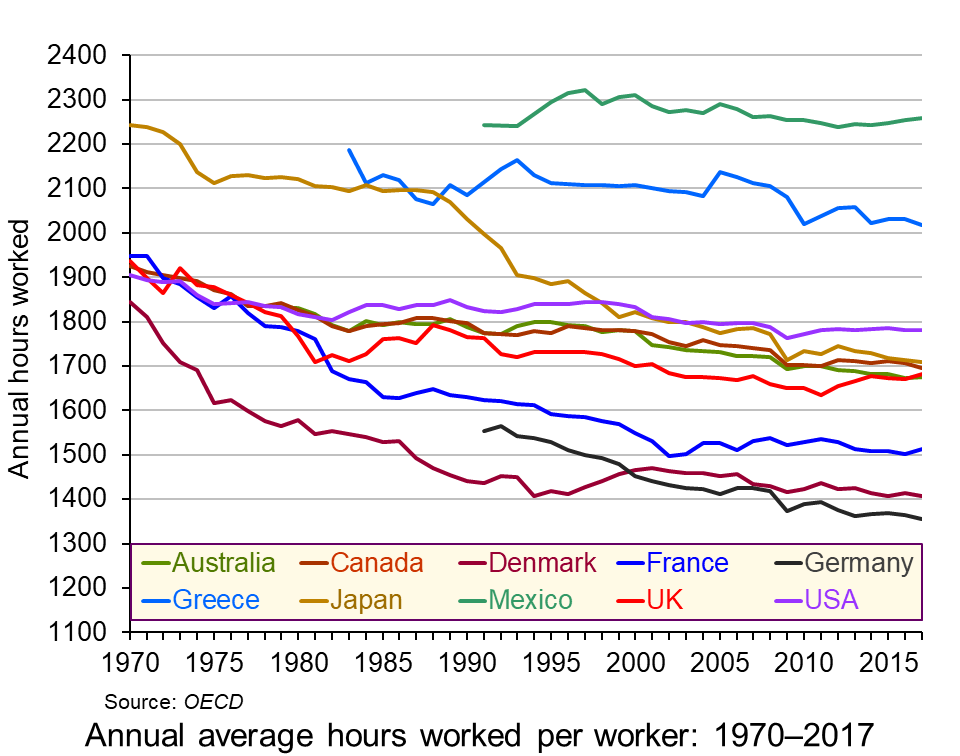 Annual working hours have been falling in most countries across the decades, as the chart shows. However, in most countries the process has slowed in recent years and in the UK, the USA and France working hours have begun to rise. (Click here for a PowerPoint of the chart.)
Annual working hours have been falling in most countries across the decades, as the chart shows. However, in most countries the process has slowed in recent years and in the UK, the USA and France working hours have begun to rise. (Click here for a PowerPoint of the chart.)
But why do working hours differ so much from country to country? How do they relate to productivity? How do they relate to human happiness and welfare more generally?
Causes of the differences
There are various reasons for the differences in hours worked between countries.
In a situation where individual workers can choose how many hours to work, they have to decide the best trade off for them between income and leisure. As wages rise over time, there will be substitution and income effects of these extra hourly wages. Higher wages make work more valuable in terms of what people can buy from an extra hour’s work. There is thus an incentive to substitute work for leisure and hence work longer. This is the substitution effect. On the other hand, higher wages allow people to work fewer hours for a given income. This is the income effect.
As incomes rise, generally the substitution effect will tend to decline relative to the income effect. This is because of the diminishing marginal utility of income. Richer people will tend to value a given rise in income less than poorer people and therefore will value the income from extra work less than poorer people. Richer people will prefer to work fewer hours than poorer people. Generally workers in richer OECD countries work fewer hours than those in poorer OECD countries.
But this does not explain why people in the USA, Canada, Japan and the UK work longer hours than people in Germany, Denmark, Norway, The Netherlands and France.
One possible explanation for these differences is the role of trade unions. These tend to be stronger in countries with lower working hours. Reducing the working week or obtaining longer holidays is one of the key objectives of unions.
Another is income distribution. The USA, despite its high average (mean) income, has a relatively unequal distribution of income compared with Germany or France. The post-tax-and-benefits Gini coefficient in the USA is around 0.39, whereas in Germany it is 0.29, meaning that Germany has a more equal distribution of disposable income than the USA. In fact, rises in real incomes in the USA over the past 10 years have gone almost exclusively to the top 10 per cent of earners, leaving the median income little changed. In fact median household income only rose above its 2007 (pre-recession) level in 2016.
 Social and cultural explanations may also be important. People in countries with higher working hours relative to hourly wages may put a greater store on consumption relative to leisure. The desire to shop may be very strong. The ‘Anglo-Saxon’ economic model pursued by right-of-centre governments in English-speaking countries, such as the USA, Canada, Australia and the UK puts emphasis on low taxes, low regulation, low public expenditure and self-advancement. Such a model encourages a more individualistic approach to work, with more emphasis on earning money.
Social and cultural explanations may also be important. People in countries with higher working hours relative to hourly wages may put a greater store on consumption relative to leisure. The desire to shop may be very strong. The ‘Anglo-Saxon’ economic model pursued by right-of-centre governments in English-speaking countries, such as the USA, Canada, Australia and the UK puts emphasis on low taxes, low regulation, low public expenditure and self-advancement. Such a model encourages a more individualistic approach to work, with more emphasis on earning money.
Then there is the attitude to hours worked generally. There is a saying that in the UK the last one to leave the office is seen as the hardest working, whereas in Germany the last one to leave is seen as the least efficient. Social pressures, from colleagues, family, friends and society more generally can have a major effect on people’s choices between work and leisure.
Productivity
Productivity, in terms of output per hour worked, tends to decline as workers work longer hours. People get tired and possibly bored and demotivated towards the end of a long day or week. If workers are paid by the output they produce and if productivity declines towards the end of the day, then the hourly wage would fall as the day progresses. This would act as a disincentive to work long hours. In practice, most workers are normally paid a constant rate per hour for normal-time working. For overtime, they may even be paid a higher rate, despite their likely lower productivity. This encourages them to work longer hours than if they were paid according to their marginal productivity.
Linking pay more closely to productivity could encourage people to opt for fewer hours (if they had the choice). Indeed some companies are now encouraging workers to choose their hours – which may mean fewer hours as people seek a better work–life balance. (See the BBC article below about PwC’s employment strategy.)  Alternatively, some other employers adopt the system of giving workers a set amount of work to do and then they can leave work when it is finished. This acts as an incentive to work more efficiently.
Alternatively, some other employers adopt the system of giving workers a set amount of work to do and then they can leave work when it is finished. This acts as an incentive to work more efficiently.
It is interesting that countries where workers work more hours per year tend to have a lower output per hour worked relative to output per worker than countries where workers work fewer hours. This is illustrated in the chart opposite. The USA, with its longer working hours, has higher output per person employed than France and Germany but very similar output per hour worked.
Hours and happiness
So are people who choose to work longer hours and take home more money likely to be happier than those who choose to work fewer hours and take home less money? If people were rational and had perfect knowledge, then they would choose the balance between work and leisure that best suited them.
In practice, labour markets are highly imperfect. People often do not have choices about the amount they work; they work the hours they are told. Even if they do have a choice, they are unlikely to have perfect knowledge about the impact of long hours on their health and happiness over their lifetime. They may not even be good judges of the shorter-term effects of more work and more pay. They may believe that more money will buy them more happiness only to find soon afterwards that they are wrong.
Articles
Data
Questions
- What factors are likely to encourage workers to work longer hours?
- Give some examples of jobs where workers have flexibility in the amount of hours they work per week and jobs where the working week is of a fixed length.
- For what reasons are annual working hours longer in the USA than in Germany?
- Would it be in employers’ interests if the government legislated so as to reduce the maximum permitted working week? Explain.
- What is meant by ‘efficiency wages’? How relevant is the concept to the issue of the average number of hours worked per year from country to country?
- Explain why people in poorer countries tend to work more hours per year than people in richer countries.
- If workers’ wages equalled their marginal revenue product, why might some workers choose to work more and others choose to work less (assuming they had a choice)?
- Are jobs in the gig economy and zero-hour contract jobs in the interests of workers?
- Is South Korea wise to cut its work limit from 68 hours a week to 52?
 The UK Chancellor of the Exchequer, Philip Hammond, announced in the Budget this week that national insurance contributions (NICs) for self-employed people will rise from 9% to 11% by 2019. These are known as ‘Class 4’ NICs. The average self-employed person will pay around £240 more per year, but those on incomes over £45,000 will pay £777 more per year. Many of the people affected will be those working in the so-called ‘gig economy’. This sector has been growing rapidly in recent years and now has over 4 million people working in it.
The UK Chancellor of the Exchequer, Philip Hammond, announced in the Budget this week that national insurance contributions (NICs) for self-employed people will rise from 9% to 11% by 2019. These are known as ‘Class 4’ NICs. The average self-employed person will pay around £240 more per year, but those on incomes over £45,000 will pay £777 more per year. Many of the people affected will be those working in the so-called ‘gig economy’. This sector has been growing rapidly in recent years and now has over 4 million people working in it.
Workers in the gig economy are self employed, but are often contracted to an employer. They are paid by the job (or ‘gig’: like musicians), rather than being paid a wage. Much of the work is temporary, although many in the gig economy, such as taxi drivers and delivery people stick with the same job. The gig economy is just one manifestation of the growing flexibility of labour markets, which have also seen a rise in temporary employment, part-time employment and zero-hour contracts.
 Working in the gig economy provides a number of benefits for workers. Workers have greater flexibility in their choice of hours and many work wholly or partly from home. Many do several ‘gigs’ simultaneously, which gives variety and interest.
Working in the gig economy provides a number of benefits for workers. Workers have greater flexibility in their choice of hours and many work wholly or partly from home. Many do several ‘gigs’ simultaneously, which gives variety and interest.
In terms of economic theory, this flexibility gives workers a greater opportunity to work the optimal amount of time. This optimum involves working up to the point where the marginal benefit from work, in terms of pay and enjoyment, equals the marginal cost, in terms of effort and sacrificed leisure.
For firms using people from the gig economy, it has a number of advantages. They are generally cheaper to employ, as they do not need to be paid sick pay, holiday pay or redundancy; they are not entitled to parental leave; there are no employers’ national insurance contributions to pay (which are at a rate of 13.8% for employers); the minimum wage does not apply to such workers as they are not paid a ‘wage’. Also the firm using such workers has greater flexibility in determining how much work individuals should do: it chooses the amount of service it buys in a similar way that consumers decide how much to buy.
 Many of these advantages to firms are disadvantages to the workers in the gig economy. Many have little bargaining power, whereas many firms using their services do. It is not surprising then that the Chancellor’s announcement of a 2 percentage point rise in NICs for such people has met with such dismay by the people affected. They will still pay less than employed people, but they claim that this is now not enough to compensate for the lack of benefits they receive from the state or from the firms paying for their services.
Many of these advantages to firms are disadvantages to the workers in the gig economy. Many have little bargaining power, whereas many firms using their services do. It is not surprising then that the Chancellor’s announcement of a 2 percentage point rise in NICs for such people has met with such dismay by the people affected. They will still pay less than employed people, but they claim that this is now not enough to compensate for the lack of benefits they receive from the state or from the firms paying for their services.
Some of the workers in the gig economy can be seen as budding entrepreneurs. If you have a specialist skill, you may use working in the gig economy as the route to setting up your own business and employing other people. A self-employed plumber may set up a plumbing company; a management consultant may set up a management consultancy agency. Another criticism of the rise in Class 4 NICs is that this will discourage such budding entrepreneurs and have longer-term adverse supply-side effects on the economy.
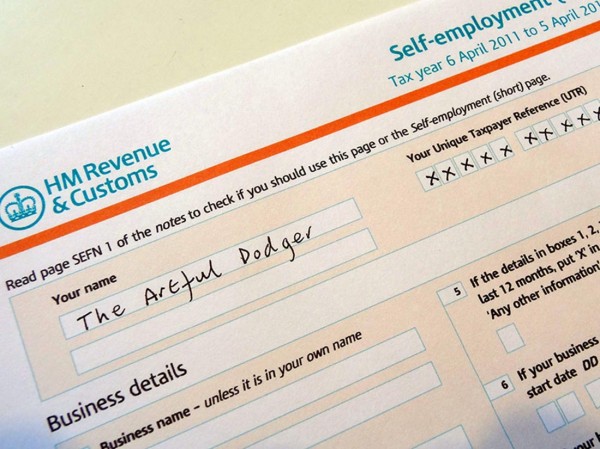 As far as the government is concerned, there is a worry about people moving from employment to self-employment as it tends to reduce tax revenues. Not only will considerably less NIC be paid by previous employers, but the scope for tax evasion is greater in self-employment. There is thus a trade-off between the extra output and small-scale investment that self-employment might bring and the lower NIC/tax revenue for the government.
As far as the government is concerned, there is a worry about people moving from employment to self-employment as it tends to reduce tax revenues. Not only will considerably less NIC be paid by previous employers, but the scope for tax evasion is greater in self-employment. There is thus a trade-off between the extra output and small-scale investment that self-employment might bring and the lower NIC/tax revenue for the government.
Articles
Thriving in the gig economy Philippine Daily Inquirer, Michael Baylosis (10/3/17)
6 charts that show how the ‘gig economy’ has changed Britain – and why it’s not a good thing Business Insider, Ben Moshinsky (21/2/17)
What is the ‘gig’ economy? BBC News, Bill Wilson (10/2/17)
Great Freelance, Contract and Part-Time Jobs for 2017 CareerCast (10/3/17)
We have the laws for a fairer gig economy, we just need to enforce them The Guardian, Stefan Stern (7/2/17)
The gig economy will finally have to give workers the rights they deserve Independent, Ben Chu (12/2/17)
Gig economy chiefs defend business model BBC News (22/2/17)
Spring Budget 2017 tax rise: What’s the fuss about? BBC News, Kevin Peachey (9/3/17)
Self-employed hit by national insurance hike in budget The Guardian, Simon Goodley and Heather Stewart (8/3/17)
What national insurance is – and where it goes The Conversation, Jonquil Lowe (10/3/17)
Britain’s tax raid on gig economy misses the mark Reuters, Carol Ryan (9/3/17)
Economics collides with politics in Philip Hammond’s budget The Economist (9/3/17)
UK government publications
Contract types and employer responsibilities – 5. Freelancers, consultants and contractors GOV.UK
Spring Budget 2017 GOV.UK (8/3/17)
Spring Budget 2017: documents HM Treasury (8/3/17)
National Insurance contributions (NICs) HMRC and HM Treasury (8/3/17)
Questions
- Give some examples of work which is generally or frequently done in the gig economy.
- What are the advantages and disadvantages to individuals from working in the gig economy?
- What are the advantages and disadvantages to firms from using the services of people in the gig economy rather than employing people?
- In the case of employed people, both the employees and the employers have to pay NICs. Would it be fair for both such elements to be paid by self-employed people on their own income?
- Discuss ways in which the government might tax the firms which buy the services of people in the gig economy.
- How does the rise of the gig economy affect the interpretation of unemployment statistics?
- What factors could cause a substantial growth in the gig economy over the coming years?
 When UK unemployment was 7.7% in July 2013, Mark Carney, the newly arrived governor of the Bank of England, said that the Bank would probably have to rise interest rates when the unemployment rate dropped below 7%. Below that rate, it was expected that inflation would rise. In other words, 7% was the NAIRU – the non-accelerating rate of inflation. The most recent figure for the unemployment rate is 4.8% and yet the Bank of England has not raised interest rates. In fact, in response to the Brexit vote, it cut Bank Rate from 0.5% to 0.25% in August last year. (Click here for a PowerPoint of the chart below.)
When UK unemployment was 7.7% in July 2013, Mark Carney, the newly arrived governor of the Bank of England, said that the Bank would probably have to rise interest rates when the unemployment rate dropped below 7%. Below that rate, it was expected that inflation would rise. In other words, 7% was the NAIRU – the non-accelerating rate of inflation. The most recent figure for the unemployment rate is 4.8% and yet the Bank of England has not raised interest rates. In fact, in response to the Brexit vote, it cut Bank Rate from 0.5% to 0.25% in August last year. (Click here for a PowerPoint of the chart below.)
The NAIRU is a similar, although not identical, concept to the natural rate of unemployment. The natural rate is the equilibrium rate consistent with an overall long-term balance of aggregate labour demand and supply: i.e. the rate after short-term cyclical movements in unemployment have been discounted. It is thus a long-term concept.
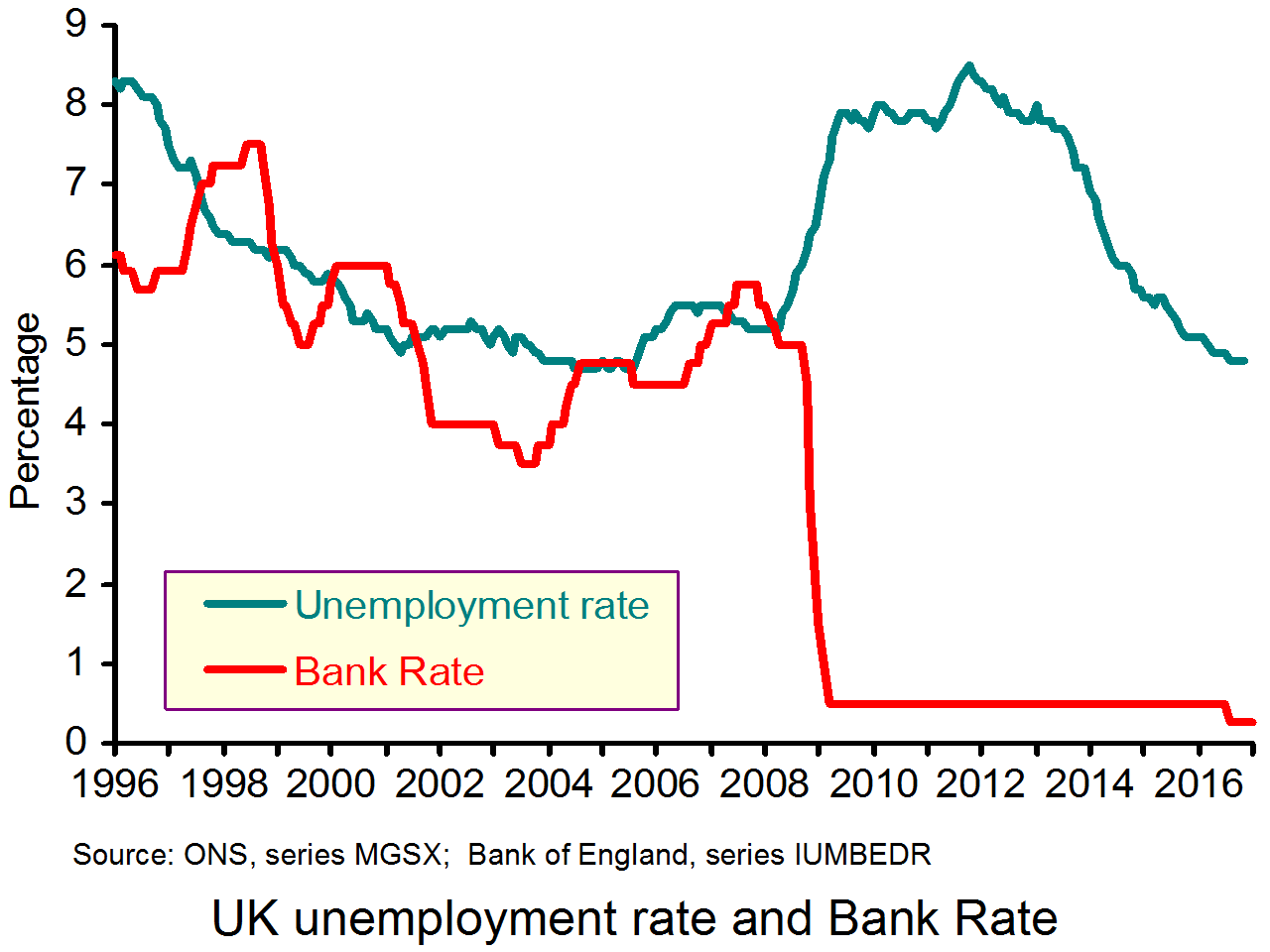 The NAIRU, although similar, focuses on the relationship between inflation and unemployment. With inflation caused solely by demand-side factors, the natural rate and the NAIRU will be similar if not identical. However, if cost-push factors change – say there is a poor harvest, which pushes up food prices and inflation (temporarily), or a substantial depreciation of the exchange rate caused by political factors (such as Brexit) – the NAIRU would increase, at least in the short term, as a higher rate of unemployment would be necessary to stop inflation rising. In the long term, although being defined differently, the NAIRU and the natural rate will be the same.
The NAIRU, although similar, focuses on the relationship between inflation and unemployment. With inflation caused solely by demand-side factors, the natural rate and the NAIRU will be similar if not identical. However, if cost-push factors change – say there is a poor harvest, which pushes up food prices and inflation (temporarily), or a substantial depreciation of the exchange rate caused by political factors (such as Brexit) – the NAIRU would increase, at least in the short term, as a higher rate of unemployment would be necessary to stop inflation rising. In the long term, although being defined differently, the NAIRU and the natural rate will be the same.
In practice, because the Bank of England is targeting inflation at a 24-month time horizon, the NAIRU for the UK at that point could also be seen as the natural rate.
So with the Bank of England not raising interest rates despite the considerable fall in the unemployment rate, does this imply a fall in the natural rate of unemployment? The answer is yes. The reason has to do with changes in the structure of the labour market.
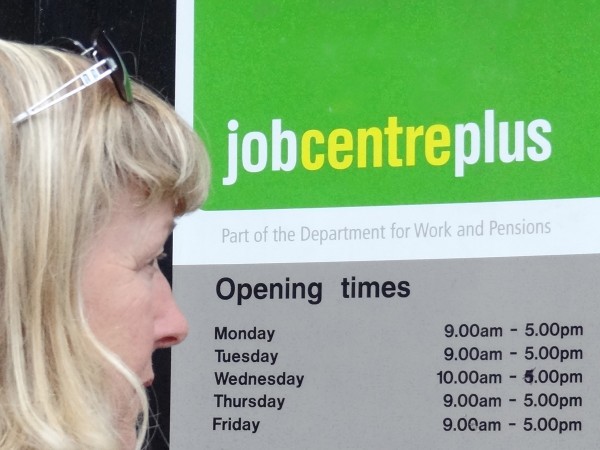 The proportion of young people and women with children returning to the labour market has fallen. Such people have a higher-than-average rate of unemployment since they typically spend a period of time searching for a job.
The proportion of young people and women with children returning to the labour market has fallen. Such people have a higher-than-average rate of unemployment since they typically spend a period of time searching for a job.
Tax and benefit reforms over the years have increased the incentive for the unemployed to take work.
Perhaps the biggest factor is a greater flexibility in the labour market. As union power has waned and as people are increasingly working on flexible contracts, including zero-hour contracts, so this has moderated wage increases. At the same time, many firms are facing increased competition both from abroad and domestically via the Internet. This has put downward pressure on prices and hence on the wages firms are willing to pay.
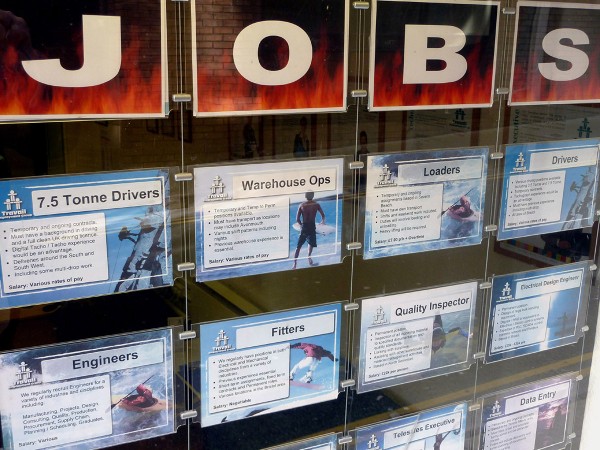 The effect has been a fall in the NAIRU and probably the natural rate. Frictions in the labour market have reduced and people losing their jobs because of changes in industrial structure find it easier to get jobs in low-skilled service industries, where employers’ risks of taking on such workers have fallen because of the loss of rights for such workers.
The effect has been a fall in the NAIRU and probably the natural rate. Frictions in the labour market have reduced and people losing their jobs because of changes in industrial structure find it easier to get jobs in low-skilled service industries, where employers’ risks of taking on such workers have fallen because of the loss of rights for such workers.
So what is the natural rate of unemployment today? It is certainly much lower than 7%; the consensus is that it is probably below 5%. As Kristin Forbes, External MPC Member of the Bank of England stated in a recent speech:
[Unemployment] is forecast to increase gradually from its current 4.8% to a high of 5.0% in the second half of 2017, before falling back to its current rate by the end of 2019. To put this in context, 5.0% was previously believed to be around the UK’s natural rate of unemployment – the rate below which unemployment could not fall without wages picking up to levels inconsistent with sustaining inflation around the 2% target. Unemployment at 5.0% is also below the average unemployment rate for the UK over the pre-crisis period from 1997 to 2007 (when it was 5.5%).
She went on to discuss just what the figure is for the natural, or ‘equilibrium’, rate of unemployment (U*). One problem here is that there is considerable uncertainty over the figure in the current forecast made by the Bank.
[An] assumption in the forecast about which there is substantial uncertainty is of the equilibrium unemployment rate – or U* for short. Since I have been on the MPC, the Committee has assumed that U* was around 5%. This implied that the more by which unemployment exceeded 5%, the more slack existed in the economy, and the less upward momentum would be expected in wages (controlling for other factors, such as productivity growth).
 As part of our annual assessment of regular supply-side conditions this January, Bank staff presented several pieces of analysis that suggested U* may be lower than 5% today [see, for example]. The majority of the MPC voted to lower our estimate of U* to 4.5%, based partly on the persistent weakness of wage growth over the past few years after accounting for other factors in our models. [See page 20 of the February 2017 Inflation Report.]
As part of our annual assessment of regular supply-side conditions this January, Bank staff presented several pieces of analysis that suggested U* may be lower than 5% today [see, for example]. The majority of the MPC voted to lower our estimate of U* to 4.5%, based partly on the persistent weakness of wage growth over the past few years after accounting for other factors in our models. [See page 20 of the February 2017 Inflation Report.]
My own assessment, however, suggested that although U* was likely lower than 5% today, it is likely not as low as 4.5%. If true, this would suggest that there is less slack in the economy than in the MPC’s central forecast, and wage growth and inflation could pick up faster than expected.
Against that, however, uncertainty related to Brexit negotiations could make firms more cautious about raising wages, thereby dampening wage growth no matter where unemployment is relative to its equilibrium. Moreover, even if we could accurately measure the level of U* in the economy today, it could easily change over the next few years as the labour force adjusts to any changes in the movement of labour between the UK and European Union.
Determining the precise figure of the current natural rate of unemployment, and predicting it for the medium term, is very difficult. It involves separating out demand-side factors, which are heavily dependent on expectations. It also involves understanding the wage elasticity of labour supply in various markets and how this has been affected by the increased flexibility of these markets.
Articles
When will Britons get a pay rise? The Guardian, Phillip Inman (26/2/17)
BoE decision, Inflation Report – Analysts react DigitalLook, Alexander Bueso (2/2/17)
Bank of England hikes UK economic growth forecasts but warns of rising inflation The Telegraph, Szu Ping Chan (2/2/17)
Bank of England publications
Inflation Report Bank of England (February 2017)
A MONIAC (not manic) economy Bank of England Speeches, Kristin Forbes (8/2/17)
The labour market Bank of England Speeches, Michael Saunders (31/1/17)
Questions
- Distinguish between the following terms: natural rate of unemployment, NAIRU, equilibrium rate of unemployment, disequilibrium rate of unemployment.
- For what reasons did the Monetary Policy Committee members feel that the equilibrium rate of unemployment might be as low as 4.25%?
- Why might it be as high as 5%?
- How are changes in migration trends likely to affect (a) wage growth and (b) unemployment?
- How is the amount of slack in an economy measured? What impact does the degree of slack have on wage growth and inflation?
- What is meant by the ‘gig’ economy? How has the development of the gig economy impacted on unemployment and wages?
- Why has there been a considerable rise in self employment?
- How may questions of life style choice and control over the hours people wish to work impact on the labour market?
- If people are moving jobs less frequently, does this imply that the labour market is becoming less flexible?
- Why may firms in the current climate be cautious about raising wages even if aggregate demand picks up?
 Artificial intelligence is having a profound effect on economies and society. From production, to services, to healthcare, to pharmaceuticals; to education, to research, to data analysis; to software, to search engines; to planning, to communication, to legal services, to social media – to our everyday lives, AI is transforming the way humans interact. And that transformation is likely to accelerate. But what will be the effects on GDP, on consumption, on jobs, on the distribution of income, and human welfare in general? These are profound questions and ones that economists and other social scientists are pondering. Here we look at some of the issues and possible scenarios.
Artificial intelligence is having a profound effect on economies and society. From production, to services, to healthcare, to pharmaceuticals; to education, to research, to data analysis; to software, to search engines; to planning, to communication, to legal services, to social media – to our everyday lives, AI is transforming the way humans interact. And that transformation is likely to accelerate. But what will be the effects on GDP, on consumption, on jobs, on the distribution of income, and human welfare in general? These are profound questions and ones that economists and other social scientists are pondering. Here we look at some of the issues and possible scenarios. Even if AI does massively boost the growth in world GDP, the distribution is likely to be highly uneven, both between countries and within countries. This could widen the gap between rich and poor and create a range of social tensions.
Even if AI does massively boost the growth in world GDP, the distribution is likely to be highly uneven, both between countries and within countries. This could widen the gap between rich and poor and create a range of social tensions.  In some industries, AI will enhance labour productivity. It will be a tool that will be used by workers to improve the service they offer or the items they produce. In other cases, it will replace labour. It will not simply be a tool used by labour, but will do the job itself. Workers will be displaced and structural unemployment is likely to rise. The quicker the displacement process, the more will such unemployment rise. People may be forced to take more menial jobs in the service sector. This, in turn, will drive down the wages in such jobs and employers may find it more convenient to use gig workers than employ workers on full- or part-time contracts with holidays and other rights and benefits.
In some industries, AI will enhance labour productivity. It will be a tool that will be used by workers to improve the service they offer or the items they produce. In other cases, it will replace labour. It will not simply be a tool used by labour, but will do the job itself. Workers will be displaced and structural unemployment is likely to rise. The quicker the displacement process, the more will such unemployment rise. People may be forced to take more menial jobs in the service sector. This, in turn, will drive down the wages in such jobs and employers may find it more convenient to use gig workers than employ workers on full- or part-time contracts with holidays and other rights and benefits. Another set of issues arises in education. What knowledge should students be expected to acquire? Should the focus of education continue to shift towards analytical skills and understanding away from the simple acquisition of knowledge and techniques. This has been a development in recent years and could accelerate. Then there is the question of assessment. Generative AI creates a range of possibilities for plagiarism and other forms of cheating. How should modes of assessment change to reflect this problem? Should there be a greater shift towards exams or towards project work that encourages the use of AI?
Another set of issues arises in education. What knowledge should students be expected to acquire? Should the focus of education continue to shift towards analytical skills and understanding away from the simple acquisition of knowledge and techniques. This has been a development in recent years and could accelerate. Then there is the question of assessment. Generative AI creates a range of possibilities for plagiarism and other forms of cheating. How should modes of assessment change to reflect this problem? Should there be a greater shift towards exams or towards project work that encourages the use of AI? Generative AI could raise global GDP by 7%
Generative AI could raise global GDP by 7% The recent pandemic has, and will have, serious implications for our economy with some estimating the largest drop in GDP ‘in living memory’. Expenditure from disposable income fell by 60% as social distancing policies were introduced and consumers started reducing their spending.
The recent pandemic has, and will have, serious implications for our economy with some estimating the largest drop in GDP ‘in living memory’. Expenditure from disposable income fell by 60% as social distancing policies were introduced and consumers started reducing their spending. However, six days after the Chancellor’s initial support package was announced, he announced a new self-employed income support scheme, which will cover up to 80% of self-employed workers’ average taxable monthly profits. This taxable grant is to be paid in a lump sum in June and will no doubt provide a vital lifeline for those workers who have seen their income disappear almost overnight.
However, six days after the Chancellor’s initial support package was announced, he announced a new self-employed income support scheme, which will cover up to 80% of self-employed workers’ average taxable monthly profits. This taxable grant is to be paid in a lump sum in June and will no doubt provide a vital lifeline for those workers who have seen their income disappear almost overnight.  The current scheme is only planned to cover the next three months. However, it is questionable whether this will be enough, and the government may have to extend the support.
The current scheme is only planned to cover the next three months. However, it is questionable whether this will be enough, and the government may have to extend the support.  Workers in the UK and USA work much longer hours per year than those in France and Germany. This has partly to do with the number of days paid holiday per year, partly with the number of hours worked per day and partly with the number of days worked per week.
Workers in the UK and USA work much longer hours per year than those in France and Germany. This has partly to do with the number of days paid holiday per year, partly with the number of hours worked per day and partly with the number of days worked per week. Annual working hours have been falling in most countries across the decades, as the chart shows. However, in most countries the process has slowed in recent years and in the UK, the USA and France working hours have begun to rise. (Click
Annual working hours have been falling in most countries across the decades, as the chart shows. However, in most countries the process has slowed in recent years and in the UK, the USA and France working hours have begun to rise. (Click  Social and cultural explanations may also be important. People in countries with higher working hours relative to hourly wages may put a greater store on consumption relative to leisure. The desire to shop may be very strong. The
Social and cultural explanations may also be important. People in countries with higher working hours relative to hourly wages may put a greater store on consumption relative to leisure. The desire to shop may be very strong. The  Alternatively, some other employers adopt the system of giving workers a set amount of work to do and then they can leave work when it is finished. This acts as an incentive to work more efficiently.
Alternatively, some other employers adopt the system of giving workers a set amount of work to do and then they can leave work when it is finished. This acts as an incentive to work more efficiently.







